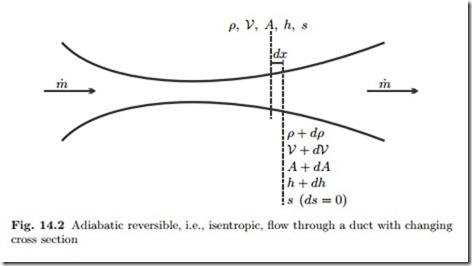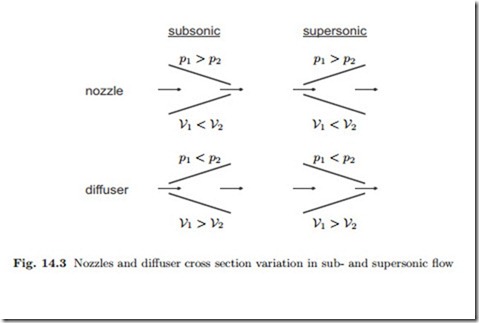Area-Velocity Relation
The main design parameter for nozzles and diffusers is the change of cross section, and we ask how flow properties, in particular velocity and pressure, change with the cross section. Figure 14.2 shows an adiabatic and reversible, i.e., isentropic, flow through a duct with varying cross section. We consider a small slice of the duct of width dx, and apply the balances of mass, energy and entropy, similar to what we did for the wave in the pipe above.
Here, h0 is the stagnation enthalpy, defined as the enthalpy the flow would obtain when brought to rest adiabatically. Since the flow is isentropic, we have ds = 0, and the Gibbs equation gives
Elimination of enthalpy between the last two equations yields the relation between pressure and velocity changes in isentropic nozzles and diffusers,
which we discussed already in Sec. 9.11. We use this to eliminate V from the mass balance to find
where the subscript indicates isentropic flow.
To proceed, we introduce the Mach number
which compares flow velocity to speed of sound: Ma < 1 for subsonic flows, Ma > 1 for supersonic flows, and Ma = 1 for sonic flows. Flows with Ma » 1 are called hypersonic and flows with Ma ‘"" 1 are called transonic.
With the definition (14.10) of the speed of sound we thus can write the relation (14.22) as
Equations (14.23) and (14.24) are the area-pressure relation and the area- velocity relation for isentropic duct flows. Both relations carry the factor (1 − Ma2) which has different sign for subsonic and supersonic flows.
Accordingly, a change of cross section has different effect when applied to sub- and supersonic flows.
Subsonic Flows (Ma<1): For a converging duct we have from (14.23, 14.24)
the flow is accelerated while pressure drops; this is a nozzle.
In other words, a converging duct acts as a nozzle in subsonic flow, but as a diffuser in supersonic flow. A diverging duct acts as a diffuser in subsonic flow, but as a nozzle in supersonic flow. Figure 14.3 shows a summary.
Related posts:
Incoming search terms:
- nozzle and diffuser flow
- compressible flow
- area - velocity relatiionship
- relations of pressure and area in diffusers
- relation between mass velocity and pressure in nozzle and diffuser
- property relation in terms of mach number nozzles diffuser
- flow with area change nozzle and diffuser
- EXPLAIN FLOW WITH AREA CHANGE IN NOZZLE AND DIFFUSER
- effect of varying cross section area in nozzle and diffuser
- Difference between Supersonic nozzle subsonic nozzle and diffuser
- compressible flow with area change for nozzle and diffusers
- Compresible area of diffuser
- area-velocity relation for nozzle and diffusor
- area velocity relationship for compressible flow derivation
- area velocity relation for diffuser
- relationship area velocity and pressure in nozzle flow







